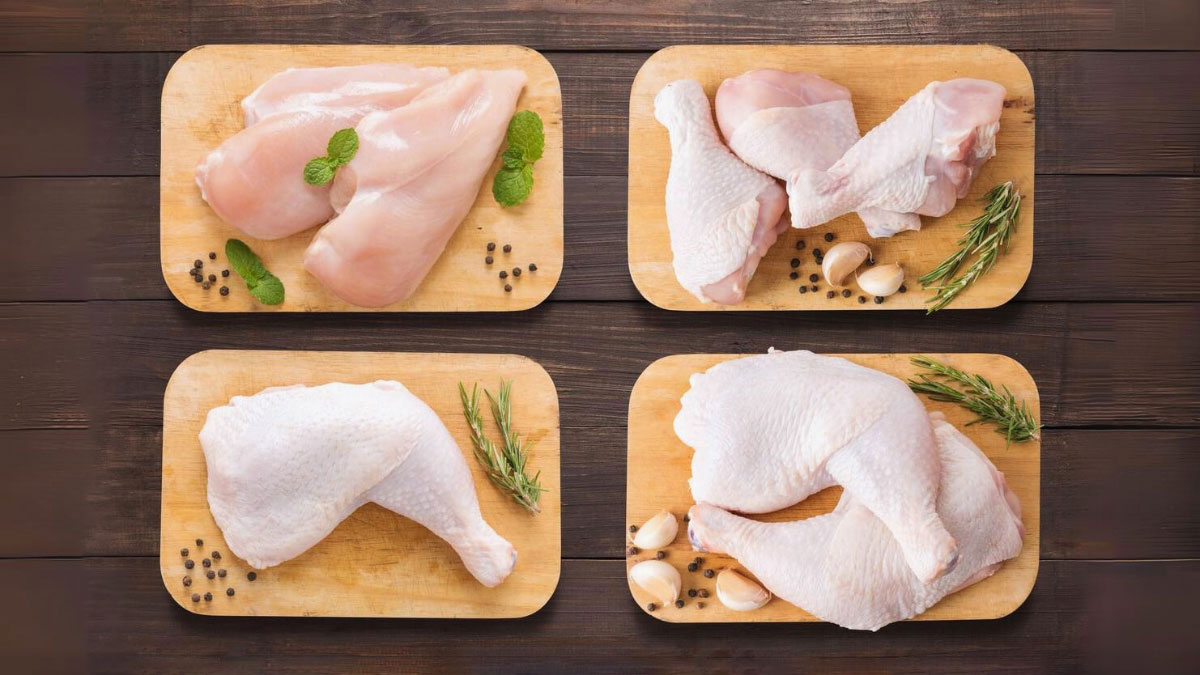How Much Does Chicken Thigh Weigh: Essential Cooking Guide
When you’re planning a meal, knowing how much chicken thigh weighs can help you portion correctly and ensure everyone gets their fill. Chicken thighs, known for their tender texture and rich flavor, come in various forms, and their weight can vary significantly. On average, a package of four chicken thighs on the bone weighs about 1.5 pounds, with each thigh yielding around 3 ounces of meat without skin or bone.
For big meat eaters, you might want to plan on two thighs per person, while one thigh is usually enough for kids or lighter eaters. Boneless chicken thighs offer a convenient option, weighing approximately 120-140 grams each. Understanding these weights helps you make informed decisions, whether you’re buying in bulk or preparing a meal for your family. By considering the weight of chicken thighs, you can better manage your portions and enjoy a delicious, satisfying meal every time.
Key Takeaways
- Understanding the weight of chicken thighs is essential for proper meal portioning, enhancing meal planning efficiency and ensuring the right amount of food per serving.
- Boneless, skinless chicken thighs typically weigh between 70 to 100 grams, making them ideal for quick meals, while bone-in thighs usually weigh 113 to 170 grams, offering a richer flavor profile.
- Cooking methods significantly affect the weight of chicken thighs due to moisture loss; grilling or roasting reduces weight considerably, while braising tends to retain more moisture.
- Knowing the weight differences between raw and cooked chicken thighs is crucial for precise dietary planning and portion accuracy.
- Several factors, including breed, diet, and cooking method, influence the weight of chicken thighs, which directly impacts the dish’s flavor and nutritional content.
Understanding Chicken Thigh Weights
Accurate knowledge of chicken thigh weights helps you plan meals more effectively and ensure appropriate portioning. You can choose between boneless skinless and bone-in thighs based on your cooking preferences.

Boneless, Skinless Chicken Thigh
When considering boneless, skinless chicken thighs, they typically weigh between 70 to 100 grams (2.5 to 3.5 ounces). This size makes them a versatile option for many dishes, such as stir-fries or casseroles, where ease of preparation is a priority. After cooking, moisture loss reduces their weight slightly, giving you approximately 116 grams, which provides 208 calories and 28.8 grams of protein.
Bone-In Chicken Thigh
Bone-in chicken thighs offer a richer flavor due to the presence of the bone and skin. They weigh between 113 to 170 grams (4 to 6 ounces). Consider this option if you’re planning a roast or grilling session where a more intense taste is desired. On average, a package of four will weigh about 1.5 pounds; each thigh can yield roughly 3 ounces of meat after being cooked.
Raw vs. Cooked Weight
The shift in weight from raw to cooked is significant. For example, 10 ounces of uncooked boneless thighs result in about 5 ounces when cooked. Moisture evaporation accounts for the difference, impacting both the weight and texture. This transformation affects nutritional content, highlighting the importance of understanding these changes for dietary planning.
Factors Impacting Weight
Several factors influence the weight of a chicken thigh. The chicken’s breed, diet, upbringing, and age are notable determinants. For example, free-range chickens might have different weight characteristics compared to factory-farmed ones, affecting both the meal’s flavor and texture. Recognizing these variations aids in making informed decisions about which type of chicken thigh to purchase.
Organizing your chicken thigh knowledge entails recognizing both the uncooked and cooked weights, deciding between boneless and bone-in options, and considering the influential factors. This understanding streamlines meal preparation, ensuring that your servings meet the dietary and culinary goals you’ve set.
Boneless vs. Bone-In Chicken Thighs
Understanding the weight differences between boneless and bone-in chicken thighs helps you choose the right option for your culinary needs. The weight impacts cooking time, flavor profile and portion size.
Average Weight of Boneless Thighs
Boneless, skinless chicken thighs typically weigh between 70 and 100 grams per thigh. This range makes them versatile for quick meal preparation. When you purchase boneless thighs, expect them to weigh approximately 105 grams in their raw state. These thighs lose some moisture during cooking, resulting in a post-cook weight reduction. For portioning, two boneless thighs per adult or one for a child are generally sufficient.
Average Weight of Bone-In Thighs
Bone-in, skin-on chicken thighs generally weigh between 113 and 170 grams per thigh. This additional weight comes from the bone and skin, which contribute to richer, more succulent flavors during cooking. Some sources indicate that bone-in thighs can weigh as much as 210 to 260 grams pre-cooking, especially when they include the drumstick. This heavier option is ideal for methods like roasting or grilling, where the skin and bone help retain moisture and enhance taste.
Factors Affecting Chicken Thigh Weight
Understanding the factors that impact chicken thigh weight helps in planning meals and selecting the right cut. Several variables influence this weight, from the bird’s origin to cooking processes.
Size of the Chicken
The size of a chicken plays a significant role in the weight of its thighs. Larger chickens naturally have heavier thighs. Breed differences also contribute, as certain breeds grow larger. For instance, commercial chickens often have larger thighs due to selective breeding. Furthermore, the diet and upbringing, including the farm environment, affect growth rates. A chicken raised on nutrient-rich feed typically develops more muscle mass, leading to heavier thighs. The bird’s age at slaughter can alter weight, with older chickens generally having denser meat.
Cooking Methods and Effects
Cooking methods alter the weight and texture of chicken thighs. Moisture loss during cooking significantly reduces weight; a raw boneless thigh of about 3 ounces can shrink to around 2 ounces when cooked. Grilling or roasting intensifies this effect due to high heat. Simmering or braising, however, retains more moisture, preserving more of the initial weight. Understanding these effects on weight lets you adjust cooking time and portion sizes for your preferred method. Experiment with different techniques to balance flavor and texture, while considering the final weight after cooking. This knowledge allows you to cater to varying tastes and dietary needs efficiently.
Nutritional Information
Understanding the nutritional profile of chicken thighs helps in meal planning. A typical bone-in chicken thigh weighing about 172 grams provides several nutrients. Here’s a breakdown:
- Calories: Contains 278 calories, offering energy for various activities.
- Fat: Provides 20.9 grams of fat, including 5.6 grams of saturated fat and 0.1 grams of trans fat.
- Cholesterol: Offers 122 milligrams of cholesterol; consider this for heart-health-focused diets.
- Sodium: Contains 102 milligrams of sodium, influencing blood pressure and fluid balance.
- Carbohydrates: No carbohydrates; an option for low-carb eating plans.
- Protein: Supplies 20.8 grams of protein, aiding in muscle repair and growth.
- Calcium: Has 9 milligrams of calcium, which supports bone health.
- Iron: This cut doesn’t offer iron, unlike some other poultry parts.
These values can vary based on factors like cooking methods and whether the skin is retained during preparation.
Cooking and Preparation Tips
Understanding weight changes during cooking helps optimize the preparation process. Chicken thighs lose weight due to moisture evaporation when you cook them. Expect approximately a 50% reduction in weight when cooking raw boneless thighs, which initially weigh around 7 ounces (198 grams).
Selection and Portioning:
- Choose bone-in thighs for roasting or grilling due to their richer flavor.
- Opt for boneless thighs for stir-fries or curries because they cook faster and absorb marinades efficiently.
Cooking Methods:
- Grill or roast for a crispy texture, noting that high-heat methods lead to more significant moisture loss.
- Simmer or braise to retain juiciness, ideal for dishes like stews where softer texture is preferable.
- Plan meals by weight post-cooking to ensure correct portion sizes; for instance, use 10 ounces of raw meat for 5 ounces cooked.
- Use a kitchen scale to measure raw ingredients accurately, aiding in effective portion control.
Chicken thigh weight impacts cooking duration and final dish texture, making it crucial to adjust your cooking approach depending on the cut.
Conclusion
Understanding the weight of chicken thighs is key to successful meal planning and cooking. By considering factors like bone-in versus boneless options, cooking methods, and nutritional content, you can make informed choices that suit your dietary needs and taste preferences. Whether you’re roasting for rich flavor or opting for boneless thighs in a quick stir-fry, knowing the weight helps ensure proper portioning and satisfying meals. Remember to account for weight changes during cooking and use a kitchen scale for precise portion control. This knowledge empowers you to create delicious and balanced dishes with confidence.







